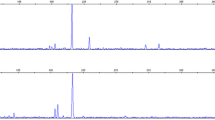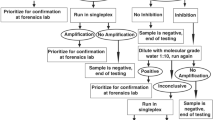Abstract
A framework for the development and validation of a qPCR assay for species identification and DNA quantification for conservation and forensic purposes is presented. Elephants are commonly poached for their ivory tusks, which is the primary driving force behind their endangered status. In addition to poaching and trade, habitat loss due to logging and mining has also resulted in loss of elephants. Crimes against animals can be deterred and/or further prosecution sought through testing with forensic genetic techniques. The creation of novel genetic assays can greatly impact wildlife forensic science investigations in identifying the species. Molecular genetic techniques can help enforce conservation efforts; however, they must be properly developed and validated to be of evidentiary quality for court systems. African and Asian elephant buccal cells were used as model in this work. The assay provides a method to differentiate biological fluids of both genera of elephants simultaneously. It can be used for identification of elephant derived products and presents valuable quantification for optimized further testing, such as microsatellite detection.


Similar content being viewed by others
References
Nyakaana S, Okello JBA, Muwanika V, Siegismund HR (2005) Six new polymorphic microsatellite loci isolated and characterized from the African savannah elephant genome. Mol Ecol Notes 5(2):223–225. https://doi.org/10.1111/j.1471-8286.2005.00885.x
Zhang L, Wang N (2003) An initial study on habitat conservation of Asian elephant (Elephas maximus), with a focus on human elephant conflict in Simao, China. Biol Conserv 112(3):453–459. https://doi.org/10.1016/S0006-3207(02)00335-X
Wozney KM, Wilson PJ (2012) Real-time PCR detection and quantification of elephantid DNA: species identification for highly processed samples associated with the ivory trade. Forensic Sci Int 219(1):106–112. https://doi.org/10.1016/j.forsciint.2011.12.006
Sukumar R (2006) A brief review of the status, distribution and biology of wild Asian elephants Elephas maximus. Int Zoo Yearb 40(1):1–8
Archie EA, Chiyo PI (2011) Elephant behaviour and conservation: social relationships, the effects of poaching, and genetic tools for management. Mol Ecol 21(3):765–778
Iyengar A (2014) Forensic DNA analysis for animal protection and biodiversity conservation: a review. J Nat Conserv 22:195–205
Linacre A, Tobe SS (2011) An overview to the investigative approach to species testing in wildlife forensic science. Investig Genet 2(1):2–9
Cooper JE, Cooper ME (2013) Wildlife forensic investigation: principles and practice. CRC, Boca Raton
Wasser SK, Brown L, Mailand C, Mondol S, Clark W, Laurie C, Weir BS (2015) Genetic assignment of large seizures of elephant ivory reveals Africa’s major poaching hotspots. Science 349(6243):84–87. https://doi.org/10.1126/science.aaa2457
Kitpipit T, Thongjued K, Penchart K, Ouitavon K, Chotigeat W (2017) Mini-SNaPshot multiplex assays authenticate elephant ivory and simultaneously identify the species origin. Forensic Sci Int Genet 27:106–115
Alacs EA, Georges A, FitzSimmons NN (2010) DNA detective: a review of molecular approaches to wildlife forensics. Forensic Sci Med Pathol 6(3):180–194
Ward RD, Zemlak TS, Innes BH, Last PR, Hebert PDN (2005) DNA barcoding Australia’s fish species. Philos Trans R Soc Lond B 360(1462):1847–1857. https://doi.org/10.1098/rstb.2005.1716
Hebert PDN, Stoeckle MY, Zemlak TS, Francis CM (2004) Identification of birds through DNA barcodes. PLoS Biol 2(10):e312. https://doi.org/10.1371/journal.pbio.0020312
Haijibabaei M, Singer GAC, Hebert PDN, Hickey DA (2007) DNA barcoding: how it complements taxonomy, molecular phylogenetics and population genetics. Trends Genet 23(4):167–172
Li R (2015) Forensic biology, 2nd edn. CRC, Boca Raton
James SH, Nordby JJ, Bell S (2014) Forensic science: an introduction to scientific and investigative techniques, 4th edn. Taylor & Francis, New York
Bustin SA, Benes V, Garson JA, Hellemans J, Huggett J, Kubista M, Muller R, Nolan T, Pfaffl MW, Shipley GL, Vandesompele J, Wittwer CT (2009) The MIQE guidelines: minimum information for publication of quantitative real-time PCR experiments. Clin Chem 55(4):611–622. https://doi.org/10.1373/clinchem.2008.112797
Altschul SF, Gish W, Miller W, Myers EW, Lipman DJ (1990) Basic local alignment search tool. J Mol Biol 215(3):403–410
Vallone PM, Butler JM (2004) AutoDimer: a screening tool for primer-dimer and hairpin structures. Biotechniques 37(2):226–231
Conte J, Potoczniak MJ, Tobe SS (2018) Using synthetic oligonucleotides as standards in probe-based qPCR. Biotechniques 64(4):177–179. https://doi.org/10.2144/btn-2018-2000
Mailand C, Wasser SK (2007) Isolation of DNA from small amounts of elephant ivory. Nat Protoc 2(9):2228
Comstock KE, Wasser SK, Ostrander EA (2000) Polymorphic microsatellite DNA loci identified in the African elephant (Loxodonta africana). Mol Ecol 9(7):1004–1006. https://doi.org/10.1046/j.1365-294x.2000.00939-8.x
Zhang B-W, Li M, Ma L-C, Wei F-W (2006) A widely applicable protocol for DNA isolation from fecal samples. Biochem Genet 44(11):494. https://doi.org/10.1007/s10528-006-9050-1
Comstock KE, Georgiadis NJ, Pecon-Slattery J, Roca AL, Ostrander EA, O’Brien SJ, Wasser SK (2002) Patterns of molecular genetic variation among African elephant populations. Mol Ecol 11(12):2489–2498
Roca AL, Georgiadis NJ, O’Brien SJ (2005) .onuclear genomic dissociation in African elephant species. Nat Genet 37(1):96–100
Opel KL, Chung D, McCord BR (2010) A study of PCR inhibition mechanisms using real time PCR. J Forensic Sci 55(1):25–33. https://doi.org/10.1111/j.1556-4029.2009.01245.x
Young CC, Burghoff RL, Keim LG, Minak-Bernero V, Lute JR, Hinton SM (1993) Polyvinylpyrrolidone-agarose gel electrophoresis purification of polymerase chain reaction-amplifiable DNA from soils. Appl Environ Microbiol 59(6):1972–1974
Wilson IG (1997) Inhibition and facilitation of nucleic acid amplification. Appl Environ Microbiol 63(10):3741–3751
Krenke BE, Tereba A, Anderson SJ, Buel E, Culhane S, Finis CJ, Tomsey CS, Zachetti JM, Masibay A, Rabbach DR, Amiott EA, Sprecher CJ (2002) Validation of a 16-locus fluorescent multiplex system. J Forensic Sci 47(4):1–13. https://doi.org/10.1520/JFS15445J
Acknowledgements
We thank Merideth Fayman, Caitlin Hoey, and Meredith Rohrbaugh for early contributions to this research project. This work would not be possible without DNA sources from Six Flags: Safari Off Road Adventure, the Cincinnati Zoo, the St. Louis Zoo, the Northeast Wildlife DNA Laboratory, Quakertown Veterinary Clinic, and the Brandywine Zoo. Thank you for your contributions. Thank you to Arcadia University’s Master of Forensic Science Program and the Department of Biological and Physical Sciences at Keystone College for providing funds towards this project.
Funding
This work has been supported by Arcadia University’s Master of Forensic Science program, Keystone College’s Department of Biological and Physical Sciences, and University of the Sciences’ Department of Biological Sciences.
Author information
Authors and Affiliations
Corresponding author
Ethics declarations
Conflict of interest
The authors declare that they have no conflict of interest.
Ethical approval
All applicable international, national, and/or institutional guidelines for the care and use of animals were followed.
Research involving human participants
This article does not contain any studies with human participants performed by any of the authors.
Additional information
Publisher’s Note
Springer Nature remains neutral with regard to jurisdictional claims in published maps and institutional affiliations.
Rights and permissions
About this article
Cite this article
Conte, J., Potoczniak, M.J., Mower, C. et al. ELEquant: a developmental framework and validation of forensic and conservation real-time PCR assays. Mol Biol Rep 46, 2093–2100 (2019). https://doi.org/10.1007/s11033-019-04660-7
Received:
Accepted:
Published:
Issue Date:
DOI: https://doi.org/10.1007/s11033-019-04660-7




